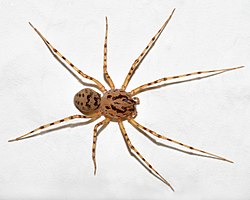| Spitting spiders Temporal range: | |
|---|---|
 | |
| Scytodes thoracica | |
 | |
| Dictis striatipes | |
| Scientific classification | |
| Kingdom: | Animalia |
| Phylum: | Arthropoda |
| Subphylum: | Chelicerata |
| Class: | Arachnida |
| Order: | Araneae |
| Infraorder: | Araneomorphae |
| Family: | Scytodidae Blackwall, 1864 |
| Diversity [1] | |
| 4 genera, 253 species | |
 | |
| blue: reported countries (WSC) green: observation hotspots (iNaturalist) | |
Spitting spiders are a family of araneomorph spiders, the family Scytodidae, first described by John Blackwall in 1864. [2] It contains over 250 species in four genera, [1] of which Scytodes is the best-known.


